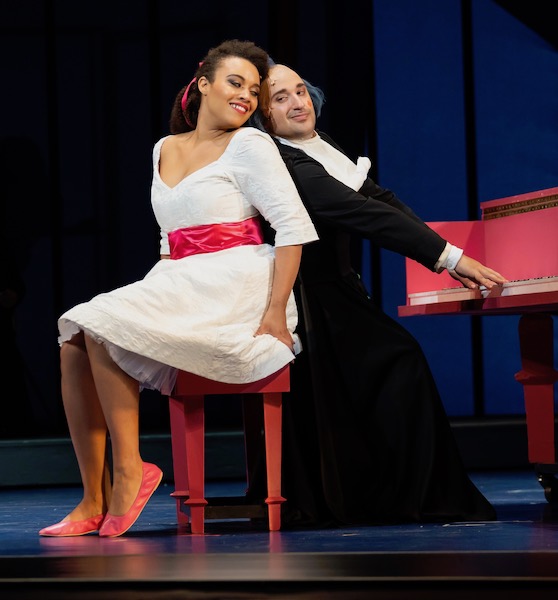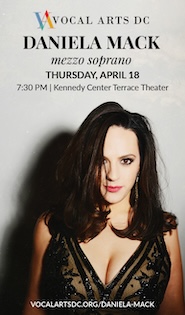Music takes center stage in Wolf Trap’s over-the-top “Barber of Seville”

The Filene Center at Wolf Trap is an awkward place to stage an opera. Amplification is a must to carry the singers’ voices through the cavernous, semi-open theater and to the audience seated on the lawn. Insects buzz, and bats fly.
Joan Font, the stage director for Wolf Trap Opera’s Barber of Seville on Friday evening, acknowledged that he not only understood the challenges involved but embraced them.
Font had a capable cast of young singers with whom to work out his ideas. The Figaro of baritone Johnathan McCullough came alive with snappy comic timing and vocal strength. Some help from the stage director might have helped his big aria, “Largo al factotum,” where McCullough ran through a limited vocabulary of gestures too quickly.
Tenor Christopher Bozeka’s clean and focused high notes gave him the right vocal swagger for Almaviva, with just enough hamminess to pull off the character’s disguises as soldier and music teacher.
The vocal sensation of the evening was the Rosina of mezzo-soprano Taylor Raven. She deployed her polished voice in an astounding range from smoky depths to a brilliant, controlled top. Her facility in melismatic passages was the best in the cast, and her stage presence was pert and appealing.
Her foil as Bartolo, bass-baritone Calvin Griffin, was equal in comic bluster. He made the daring choice to sing the old-fashioned aria “Quando mi sei vicina” entirely in falsetto during the music lesson scene in Act II. Bartolo offers the piece, which he attributes to Caffariello, to counter the aria from the new-fangled opera L’inutile precauzione. (Caffariello was the nickname of the castrato Gaetano Majorano, and by claiming to have heard him sing, Bartolo is revealing that he must be 75 to 80 years old, as scholar Albert Gier has pointed out.)
Bass Patrick Guetti showed off his dark-hued deep notes as Basilio, revealing the humorous side of his voice after the menace of his Sparafucile in last year’s Rigoletto. He made the most of his tall, lanky form with ridiculous movements and stances. Mezzo-soprano Niru Liu was demure as Berta, shining in the aria “Il vecchiotto cerca moglie,” often cut from modern productions.
In recent years the National Symphony Orchestra has accompanied these one-time performances at the Filene Center. This year it was the players of the Wolf Trap Orchestra in the pit, led by conductor Lidiya Yankovskaya, a regular with Wolf Trap Opera in recent years and, since 2017, music director of Chicago Opera Theater. She admirably took her time with the overture and many numbers in the opera, avoiding the tendency among today’s opera buffa conductors toward manic speed.
The small male chorus was vocally strong but wayward in ensemble sensitivity, often getting way ahead of Yankovskaya’s eminently clear beat in fast choral numbers. The orchestra, less unified and confident than the NSO would likely have been, hewed close to the conductor’s pace, with some talented playing from oboe, piccolo, and horn.
Font adapted this staging for Wolf Trap from his production at Houston Grand Opera. Cesare Sterbini’s libretto is unusual for how much it references the idea of music and performance. Three of the characters pretend to sing musical pieces during the opera. Rosina and Bartolo both sing arias in the music lesson scene, while Almaviva sings two serenades in the first act, one of them accompanied by guitar, played here with admirable flexibility and character by Candice Mowbray.
The staging emphasized the role of music with large, colorful set pieces (scenic design by Joan Guillén) shaped like gigantic instruments. A colorful guitar served Almaviva as a pedestal in his serenade, accompanied by a troupe of guitarists, and a double-wide piano doubled as performing platform in the second act.
The set rotated, moving from the street in the first scene, with transparent walls revealing the interior spaces, to the inside of Bartolo’s house. Costumes and make-up were broad and farcical, as were the little dumbshows carried out by supernumeraries throughout the show, more of a distraction than a feature.







